
The Temple in Jerusalem, or alternatively the Holy Temple, refers to the two religious structures that served as the central places of worship for Israelites and Jews on the modern-day Temple Mount in the Old City of Jerusalem. According to the Hebrew Bible, the First Temple was built in the 10th century BCE, during the reign of Solomon over the United Kingdom of Israel. It stood until c. 587 BCE, when it was destroyed during the Babylonian siege of Jerusalem. Almost a century later, the First Temple was replaced by the Second Temple, which was built after the Neo-Babylonian Empire was conquered by the Achaemenid Persian Empire. While the Second Temple stood for a longer period of time than the First Temple, it was likewise destroyed during the Roman siege of Jerusalem in 70 CE.

A synagogue, sometimes referred to as a shul or a temple, is a house of worship in Judaism. Synagogues have a place for prayer where Jews attend religious services or special ceremonies such as weddings, b'nai mitzvah, choir performances, and children's plays. They also have rooms for study, social halls, administrative and charitable offices, classrooms for religious and Hebrew studies, and many places to sit and congregate. They often display commemorative, historic, or modern artwork alongside items of Jewish historical significance or history about the synagogue itself.

The Temple Mount, also known as Haram al-Sharif, al-Aqsa Mosque compound, or simply al-Aqsa, and sometimes as Jerusalem's holyesplanade, is a hill in the Old City of Jerusalem that has been venerated as a holy site in Judaism, Christianity, and Islam for thousands of years.

The Western Wall, known in the West as the Wailing Wall, and in Islam as the Buraq Wall, is a portion of ancient limestone wall in the Old City of Jerusalem that forms part of the larger retaining wall of the hill known to Jews and Christians as the Temple Mount. Just over half the wall's total height, including its 17 courses located below street level, dates from the end of the Second Temple period, and is believed to have been begun by Herod the Great. The very large stone blocks of the lower courses are Herodian, the courses of medium-sized stones above them were added during the Umayyad period, while the small stones of the uppermost courses are of more recent date, especially from the Ottoman period.
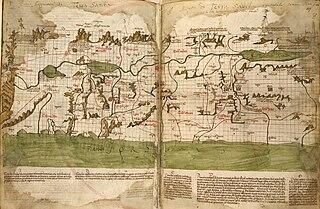
The Holy Land is an area roughly located between the Mediterranean Sea and the eastern bank of the Jordan River, traditionally synonymous both with the biblical Land of Israel and with the region of Palestine. Today, the term "Holy Land" usually refers to a territory roughly corresponding to the modern states of Israel and Palestine. Jews, Christians, Muslims, and Baháʼís regard it as holy.
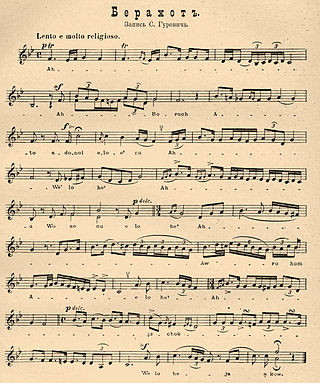
The Amidah, also called the Shemoneh Esreh, is the central prayer of the Jewish liturgy. Observant Jews recite the Amidah at each of three daily prayer services in a typical weekday: morning (Shacharit), afternoon (Mincha), and evening (Ma'ariv). On Shabbat, Rosh Chodesh, and Jewish festivals, a fourth Amidah (Mussaf) is recited after the morning Torah reading, and once per year a fifth Amidah (Ne'ilah) is recited, around sunset on Yom Kippur. Due to the importance of the Amidah, in rabbinic literature it is simply called "hatefila". According to legend, the prayer was composed by the rabbis of the Anshei Knesset HaGedolah. Accordingly, in Judaism, to recite the Amidah is a mitzvah de-rabbanan, i.e., a commandment of rabbinic origin.
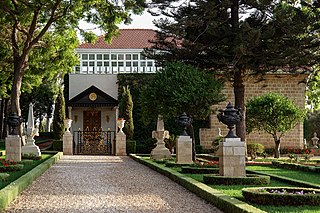
In the Baháʼí Faith the Qiblih is the location to which Baháʼís face when saying their daily obligatory prayers. The Qiblih is fixed at the Shrine of Baháʼu'lláh, near Acre, in present-day Israel; approximately at 32°56′37″N35°5′31″E.

A Torah ark refers to an ornamental chamber in the synagogue that houses the Torah scrolls.
In Judaism, Nusach (Hebrew: נוסח, romanized: nusaḥ, Modern Hebrew pronunciation nusakh, plural refers to the exact text of a prayer service; sometimes the English word "rite" is used to refer to the same thing. Nusakh means "formulate" or "wording".
The "Third Temple" refers to a hypothetical rebuilt Temple in Jerusalem. It would succeed Solomon's Temple and the Second Temple, the former having been destroyed during the Babylonian siege of Jerusalem in c. 587 BCE and the latter having been destroyed during the Roman siege of Jerusalem in 70 CE. Although it remains unbuilt, the notion of and desire for the Third Temple is sacred in Judaism, and particularly in Orthodox Judaism. It is anticipated as the most sacred place of worship for Jews. The Hebrew Bible holds that Jewish prophets called for its construction to be fulfilled prior to, or in tandem with, the Messianic Age. The building of the Third Temple also plays a major role in some interpretations of Christian eschatology.
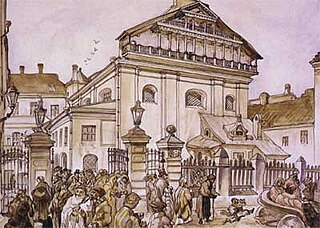
The Great Synagogue of Vilnius, which once stood at the end of Jewish Street (I-2), Vilnius, Lithuania, was built between 1630 and 1633 after permission was granted to construct a synagogue from stone. Standing on the spot of an existing synagogue built in 1572, the site had first been used to house a Jewish house of prayer in 1440. Damaged in World War II, it was demolished in 1955–1957 and replaced by a kindergarten and a primary school.

David's Tomb is a site that, according to an early-medieval (9th-century) tradition, is associated with the burial of the biblical King David. Historians, archaeologists and Jewish religious authorities do not consider the site to be the actual resting place of King David. It occupies the ground floor of a former church, whose upper floor holds the Cenacle or "Upper Room" traditionally identified as the place of Jesus' Last Supper and the original meeting place of the early Christian community of Jerusalem.

Since the 10th century BCE, Jerusalem has been the holiest city, focus and spiritual center of the Jews. Jerusalem has long been embedded into Jewish religious consciousness and Jews have always studied and personalized the struggle by King David to capture Jerusalem and his desire to build the Holy Temple there, as described in the Book of Samuel and the Book of Psalms. Many of King David's yearnings about Jerusalem have been adapted into popular prayers and songs. Jews believe that in the future the rebuilt Temple in Jerusalem will become the center of worship and instruction for all mankind and consequently Jerusalem will become the spiritual center of the world.
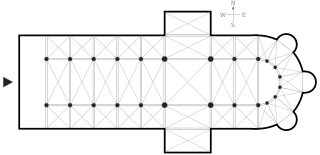
The orientation of a building refers to the direction in which it is constructed and laid out, taking account of its planned purpose and ease of use for its occupants, its relation to the path of the sun and other aspects of its environment. Within church architecture, orientation is an arrangement by which the point of main interest in the interior is towards the east. The east end is where the altar is placed, often within an apse. The façade and main entrance are accordingly at the west end.

Córdoba Synagogue is a historic edifice in the Jewish Quarter of Córdoba, Spain, built in 1315. The synagogue's small size points to it having possibly been the private synagogue of a wealthy man. It is also possible that Córdoba's complex of buildings was a yeshivah, kollel, or study hall. Another possibility is that this was the synagogue of a trade guild, which converted a residence or one of the work rooms into the synagogue. The synagogue was decorated according to the best Mudejar tradition.

Ad orientem, meaning "to the east" in Ecclesiastical Latin, is a phrase used to describe the eastward orientation of Christian prayer and Christian worship, comprising the preposition ad (toward) and oriens, participle of orior.
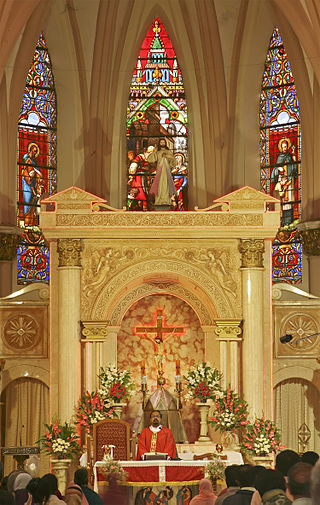
Versus populum is the liturgical stance of a priest who, while celebrating Mass, faces the people from the other side of the altar. The opposite stance, that of a priest facing in the same direction as the people, is today called ad orientem or ad apsidem.

At present, the Government of Israel controls access to the Temple Mount, also known as Al-Aqsa Mosque compound, in East Jerusalem's Old City, which is a holy place for Muslims, Jews, and Christians and an Islamic religious endowment under the management of the Jordan-based Jerusalem Islamic Waqf. There are entry limits to the Temple Mount for political and security reasons. In addition, Jewish religious law imposes restrictions on religious Jews on entering the compound.
Fixed prayer times, praying at dedicated times during the day, are common practice in major world religions such as Judaism, Christianity, and Islam.
Prayer in a certain direction is characteristic of many world religions, such as Judaism, Christianity, Islam and the Bahá'í Faith.

















